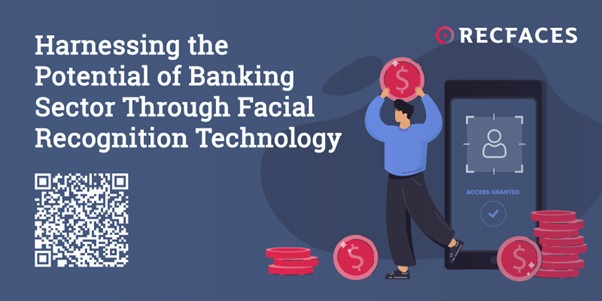Strengthening Digital Banking Frontiers with Facial Recognition Technology

The evolving digital state of economies is also witnessing an evolution in corresponding threats and risks. And in the new era of digital banking, online fraud has emerged as the most concerning threat to transactions and banking security. According to a 2022 report by Association of Certified Fraud Examiners (ACFE), a whooping USD 4.7 trillion is lost to online frauds out of the total global corporate revenue every year.
This alarming number is expected to rise manifold in the coming years. As a virtue of technological ease to commit cybercrime, all that is needed is certain technical knowledge and access to the right computer equipment. Online frauds is on the road to become the topmost threat to banking efficiency and performance.
Other than costing tens of thousands of monetary losses, online frauds also dent the reputation of the banks and put the customers’ trust to test. Unfortunately, such losses can take years to recover. However, as neobanking becomes universally prevalent, banks have no option but to devise strategies and integrate technologies that incapacitate the efforts to commit frauds.
Criticality of Synthetic Frauds
As the banking landscape changes, identity frauds have become a major roadblock for secure payments and is increasing at a concerning rate. The cost of synthetic identity fraud is projected to rise to USD 5 billion in 2024, which is double of its cost from USD 2.5 billion in 2022. The ever-evolving banking processes, as a counterpart of the global digitization wave, are set to become the reality of tomorrow.
So, it is difficult to accurately verify if the person sitting behind the virtual wall is an actual user or a synthetic identity created to perform a breach and steal valuable data. Such data becomes an easy target of fraudsters when accessed on unprotected or hyper-public networks and puts critical information at risk. The advisories towards performing checks on networks are often eye-balled, leading to compromise of not only personal data but integrated critical data as well.
Scams and phishing attacks have put customers into a constant state of distress. Often posed as authentic transactions, scams are difficult to make out. Fraudulently extracting personally identifiable information (PII) for personal and financial gains is another challenge to security and data breaches across online channels. Sophisticated technology frauds through phishing and hacking are dangerous, leading to personality duping. E-commerce frauds from data leaks, gaining unauthorized access to payment accounts, man-in-the-middle attacks and false billing hinder sectoral and economic growth.
Ineffectiveness of Traditional Fraud Prevention
Governments lose 0.5% to 5% globally on account of frauds. With the changing payment systems, the state of threats is also changing to be more dangerous, easily blended in with legitimate practices. The existing ways of identity authentication, information encryption and incident detection fall short at countering the security threats.
Since passwords and PINs have been quite established in the online banking ecosystem, the fraudsters have found ways to go around and defy such layers to gain unauthorized access. Security questions and unique identifiers can easily be predicted and memorized. Passwords and PINs can be compromised on public networks, easily forgotten and skimmed. Consequently, the frauds recorded in the past two years have been the highest in 20 years. And global payment frauds are further estimated to rise to USD 40.62 bn by 2027. Multi-factor authentication is still not universally adopted, limited to weak passwords and fingerprint biometrics.
It is to say that the traditional fraud prevention techniques are inefficient to protect the ever-rising online banking user count. Economies realize that the effects of such stolen money can range between executing small purchases online to mobilizing funds towards illegitimate funding for terrorist activities. So, it is crucial to build reliable solutions to cater the changing security requirements with immediate action.
Curtailing Frauds Through Facial Recognition Systems (FRS)
Facial biometrics has emerged as a conventional solution with a focused application in fraud prevention. According to a report by Juniper Research, the experts expect digital identity verification checks in fintech and payments markets to amount to 70 billion in 2024. This shows a significant growth of 16% from the previous year’s number of 61 billion. The powerful features of liveness detection, quick identification and accuracy make Facial Recognition Systems (FRS) almost fool-proof.
- It strengthens the multi-factor authentication regime, acting as an added layer of verification that can be applied across payment modalities. FRS, when integrated as a second or third factor of authentication, allows checking and rechecking for authentic identities, making verification more credible.
- FRS is also a major component of the fraud prevention strategy. According to the State of Fraud Report 2023 by Alloy, behavioral biometrics and selfie verification are the most important tools for fraud prevention. This growing inclination is a result of accurate threat detection and temporary account locking functions made possible through FRS.
- In the current state of technology, facial biometrics has achieved 99% accuracy, and is still improving with rapid advancements in algorithms to achieve higher inclusivity and precision. When a face image is used as the unique ID to validate online payments, the chances of frauds are reduced to near zero.
- The questions of identity theft and forgery can be rested with the implementation of countering AI-enabled solutions. Liveness detection quickly differentiates an actual person from a fictitious identity and raises alerts of attempted breach.
- PII secured with facial biometrics as the key keeps it safe from leaks and thefts. Face image helps access resources and make transactions, reducing the risks of illicit uses and phishing attacks.
Forming a Secure Future
Financial institutions and governments alike are aware of the scale of problems online fraud poses and seek reliable technologies for effective prevention. Online banking is becoming a part of everyday routine for consumers. However, it is important to take steps to ensure that online frauds are not as omnipresent. With the emergence of AI, exploration of its capabilities to build a robust financial environment is more critical than exciting. As the threats of online frauds loom, facial recognition technology can be trusted to provide the most optimal solution that not only improves security but also expands the competencies of the existing operational efforts.
“In order to ensure that security moves with the pace of advancements in digital banking, facial recognition technology can act as a backbone of support. Not only does it reduce the risks of frauds, but accelerates the speed of the banking revolution.” – Eugenia Marina, Business Development Director, MENA region, RecFaces.
“In our digital world, facial recognition stands as the unwavering guardian of online security. It’s the trusted shield that keeps fraudsters at bay while preserving convenience for all.” – Valerie Lapteva, Business Development Director, APAC region, RecFaces.







